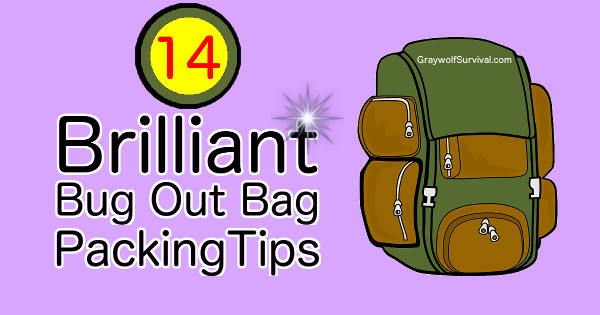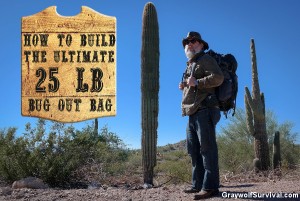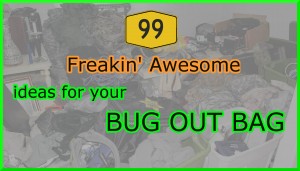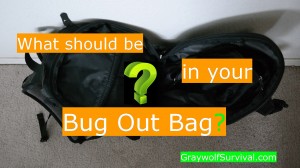 Before you’re ready for the list of what goes into a bug out bag, you need to consider these
Before you’re ready for the list of what goes into a bug out bag, you need to consider these 10 14 bug out bag packing tips. These are just a quick overview of things to keep in mind.
1 Don’t pack more than what you’ll need. When you’ve made your list of what you need, go through it and start getting rid of things. A bug out bag should hold essentials, not your whole life. You won’t be able to carry 80 pounds of gear very far, and even if you do, you won’t be very fast. Make your list, then prune it. Then prune it again. This is important. Whatever you’ve packed, you’ve probably packed too much. Try walking through your neighborhood for a few miles with it and see how it carries. After that, take it out somewhere that has hills. You’ll be surprised just how heavy a bug out bag is after trying to take it up and down a hiking trail. Now think if you were in a hurry? Just for reference, my bag is only 25 pounds plus what water I need to carry and maybe some GORP.
2 Leave some room. You’re going to run across things while you’re out prepping and if SHTF and if you don’t have room for it, you’ll have to either pass it up or dump something important. Leave some room for those items. Survival also depends on capitalizing on opportunities. Your bug out backpack needs to fit things that you find along the way or have to replace if they break. You may need to be moving through an area and pick up tinder or kindling to take to another area because it’s not always easy to find in a survival situation. If you don’t have room in your pack, you’ll be carrying it in your hands. This isn’t like luggage where you can hand it off to someone; you’ll have to carry it or wear it unless you have some kind of container for it that you’re wearing on your back.
3 Rotate your stock. Rotate your survival and/or prepping food, vitamins, and medicine. This goes the same for what you keep at home too. Don’t pack a cellar full of food and lock it up. You should be going through it along with your fridge food. Keep track of what you have and when you need to replace it. You don’t want to wait until SHTF to find out your food’s gone rotten or your meds are expired.
4 Things cost more than they seem. An important tenet to camping and survivalism is that everything has an opportunity cost associated with it. You only have so much room in your bug out bag, can only carry so much weight, and have only so much money. Choosing one thing means you’ve lost the opportunity to choose something else. Choose wisely and learn to prioritize by making a list and a bug out plan. You can’t have it all; where would you put it?
5 You’re gonna survive with what you brung. A $4 flashlight you have in your pocket is worth more than the $600 Surefire you left at home. I have several flashlights of all different sizes, power and colors but the one I use far and beyond more than the others is the little Surefire E1L that I keep in my pocket. I’ve had it in Iraq, several countries in Africa, Thailand, and Afghanistan. It’s an awesome little light. Always bring a backup. the 7 watt, 300 lumin Cree light takes AA batteries and is freaking super bright and indestructible.
You should have some kind of shelter with you. A lot of people just bring a tarp and a hammock but ultralight tent technology has improved greatly and prices have come down. An ultralight backpacking tent may make more sense – and be a LOT more comfortable.
6 Two is one and one is none. When SHTF, Murphy is going to be along for the ride. Sure as shit, when you sorely need something, you’ll reach for it and it’ll be gone, broken or malfunctioning. Keep spares of all your most important things.
7 Overlap your capabilities. You need to have duplicates of what you put into your different bags from each category but they don’t have to be exact duplicates. You may only have time to grab one bag so make sure your bases are covered. You don’t want to be stuck because your firestarting kit is in another bug out bag and you don’t want to have only way to do things by packing the same thing in every bag. You also don’t want your backup to be another lighter if lighters aren’t working due to weather, etc.
Choosing things that can perform more than one function can also help make sure you have overlap in capabilities without having to add equipment.
You may have a couple of fish hooks in your EDC (everyday carry bag) along with some fishing line, and then some lures and more hooks and line in a larger bag, and then a fishing pole with everything in your largest bag. Each bag should be able to stand alone on some level. I have a collapsible fishing rod, for example, in my pack a lot of times. It’s not completely necessary because you can just use a stick but it is a lot easier.
8 Have more than one bug out bag. You should theoretically have several but that may not be feasible. Consider also not keeping everything at your house. You may not be able to get to it if SHTF. You may want to keep some items at a friend’s house or even stash them, hidden somewhere in the woods where you can get them later. For instance, I have a 13 pound go-bag that I carry everywhere and then have a main backpack that I carry if I’m going on a search and rescue or if SHTF. Either one will work if I had to survive and they augment each other if I’m lucky enough to have both in a survival situation.
9 Keep your bags ready to go. Don’t have them lying all over the floor after you finish counting things or get back from a camping trip. It’s better to grab what you have at short notice than not be able to grab much because you didn’t have time. You’re trying to plan for worst case here and worst case is that you only have a few minutes to go. Don’t spend it packing.
10 Your bug out bags should be packed based on bug out plan. It’s difficult to know what you’ll need to pack if you don’t know where you’ll be or what you’ll be doing. Plan first; then pack. Do some research into why you need things before you just take someone’s word that you do, especially if they’re trying to sell you something. You should have a bug out route already specified, and that route may include cache locations that can supplement your bug out bag.
11 Dual-usage items cost half the weight and space. There are many solutions to each category below. Some of those solutions will also serve to fulfill what you need in other categories. Try to do this as much as possible. Survival is about creativity. Be creative and you’ll survive.
12 Learning skills can mean less equipment you’ll have to carry. If you can make a field-expedient fishing pole, for example, you don’t need to pack a fishing pole. Learn how to do and make things in the wild. Skills can also be bartered.
13 Pack the heaviest things closest to your back. The farther something is away from the leverage point, the more it pulls. Imagine holding your bug out bag close to your chest. You could do that for quite a while. Now imagine holding it in your hands with your arms stretched way out. How long could you hold it then? It’s the same weight. It’s the same thing with a backpack. Put the heaviest things as close to you as possible so it doesn’t put undue stress on you. Put them as close to your spine as possible.
14 In addition to weight, pack by urgency and frequency of use. Put the stuff you need a lot at the top and the stuff you don’t need a lot at the bottom. If you have a bag that allows access by opening all the way, it’s not that big a deal, but it may help you find things quicker.
Here’s a pleasant video from REI that explains what to put where.
If you want a thorough examination of what goes into a bob bag, see my other post on What to pack in a survival bag or if you want to see what I’ve packed in my bug out bag, check out How to build the ultimate 25 pound bug out bag.









Rock solid article!
Down-sizing: When I was younger, I thought MORE was always better. I was a fit soldier, and felt I could ruck my weight in gold. As I’ve aged, however, I’ve grown much wiser. SKILLS are indeed more important than gear. The more I know and learn how to live off the land and such, the less stuff I need to carry on my back. Besides, my back is getting older, too…
What helped me/us, was those stupid PBS travel shows by Rick Steves. This guy travels the world with essentially what amounts to a day-pack. HOW does he travel so light?!!!!
First, he has (some) skills and knowledge. He knows how to provision enroute, and on-the-fly. Why bring the whole bathroom with your to Europe or whatever, if they have toiletries that you can buy there? Ditto for clothes, food, gear, etc. Why bring, what you hotel already offers, or that you can get in-country.
Think about it this way: People live in Europe already. All the modern conveniences are already there. In THEORY, a person should be able to travel with just the clothes on their backs, their Passports, and their credit/debit cards. e.g. BUY whatever you need once you get there. Thus, you will return home with LOTS of souvenirs!
Well, a similar thought-process can be applied to our bug-out bags. Think about the things you are really, REALLY going to NEED. Why bring three knives, when ONE will do?
I also liked what Rick Steves said about pack size/weight. He said we should basically put our backpack on the ground, and kick it like a football. If we are concerned about breaking something inside, then those items do NOT belong with us. e.g. we have to PREPARE for breakage and rough roads ahead. Similarly, if we break out foot kicking our backpack, then it’s just too darned heavy!!! It will weigh us down, make us too immobile, be too tempting to thieves, and generally ruin our whole comfort/experience. Whereas, a light-weight approach, keeps us in better mental condition, and puts more pep in our step — and keeps us active/moving faster, further. Covering a LOT of ground on one of the most important goals during a bug-out scenario. Put as much distance between yourself, and danger — as QUICKLY as possible. Reprovision and restock once you get to your destination.
Lastly, I would encourage people to think in tiers. You bug-out bag is just ONE tier of what you will be carrying. It’s the heaviest, bulkiest tier. We should also plan to have a belt-based tier of pouches and holsters. We should plan to have pocket-based tiers of EDC items. I also like to additionally have a chest-based tier to help offset the back-based ruck. I find that this helps reduce my back strain, and helps me travel in a more upright position. I consider my chest-tier to be somewhat of a ditch-bag, or cache-drop bag. So, if I need to drop weight, I know EXACTLY what items will be falling off my body — (instead of ditching EVERYTHING, or ditching in an unplanned manner.)
As you pack your bug out bag, simply limit the contents to must-have items only. Shove all the “nice-to-have” or backup/redundant items into your chest/ditch bag, instead. Thus, your net weight will still be the same. But, if you have to ditch, you will probably reduce your load by 30% or more?!!! Toss/drop it, hit the man-overboard button on your GPS, and soldier onward. (You can return to retrieve it later if necessary.) CLEAR-OUT first!!! Seek safety & security. Only return to fetch your ditch bag if/when it’s safe to do so.
P.S. I like to keep a “boot tier,” too. I simply have a set of well-worn bug-out boots ready-to-go. These are thigh-high, military-grade boots. At the top of them, I have items pre-clipped to them — like a boot knife, a small flashlight, and a money clip. I have a small compass laced into one of the boot laces. Thus, I can just slip-on my boots, and pickup a half-dozen additional items by default. Thus, even if I have to drop my MAIN bug out bag enroute, I’m not “nekid” of supplies. I have a knife, flashlight, compass, (and a few other select items) still on my person.
Again, I enjoyed your article! I just wanted to offer a few additional tips.
Peace.
Great comments J H. I apologize for not saying something sooner. My comment thingy never told me that you had commented so I didn’t see it until just now. Please keep visiting. I enjoy your point of view.
Yes is in Europe do have all the amenities that’s available in the states. And there those of us that do indeed travel very light,a small holdall taking only the essentials and then we get gear at our destination. But I envy you Americans sometimes you can get stiff we can’t.
Stuff not stiff, damn autocorrect.
Definitely important NOT to have all your BOB’s in your house! About 6-1/2 years ago, when I lived in a rental house, there was a natural gas leak under the house, that I never smelled (while it was filling the crawl space with gas), that finally ignited at ~0230, when it finally filled the crawlspace, and started coming up into the house! Needless to say, there wasn’t much left of that house!!
Miraculously, I got out without a scratch…..and there wasn’t a follow-up fire…..but the insurance company called it a total loss, of the house AND my contents inside! A nice BOB in my truck would have got me through the first couple days, with ease, instead of having to go out and find replacement clothing, toiletries, etc.
You wrote “If you want a thorough examination of what goes into a bob bag, see my other post on What to pack in a survival bag or the one on what I have currently in my go bag.”. It sounds as though you put your Bug Out Bag (BOB) in a bag…
Great list. I would add one more thing: test your bag and everything in it.
As you mentioned, it’s it’s important to go hiking with your BOB to determine if you can realistically move with everything you’ve packed. Likewise, it’s important to use your gear in realistic settings to make sure you understand how to use it and ensure that it actually works the way it’s supposed to.
I’ve made quite a few changes to my BOB and BO plan based on lessons I’ve learned from using the gear.
One model of a pocket knife even has its own reusable plastic toothpick,
which you might have forgotten to include in your
checklist.
Yes, I have this one! Oh, this article is so useful, I was very messy packer, but I’m making significant progress lately… my target for the next travel is to take only one bag and will definitely use some tips from here, thank you!
need to set up was thinking(and it hurt) on this the other day where can a hard list or looks like a guide book or booklet be had ? thanks for the info .
This is my personal list:
My 25-pound bug out bag
You might also try this book:
Build the Perfect Bug Out Bag: Your 72-Hour Disaster Survival Kit
Is there a way to make the page printer friendly? Maybe I’m missing the button 😉 I’d love to print this out and have it in my resource binder, but it shows up all wonky when I try to print!
Sorry, it comes out this way due to the theme being used.
Thanks. For the I information all is things that I have started to think about. I have been thinking about survival here at home. Saved a few milk jigs to get water in flashlite matches dry goods like beans rice etc.water filter. Garden,garden seeds,just thinking But now will plan back pack in case have to go fast. Saw a homeless man I. Town and his backpack. And wondered what he had in it and what he did to survive. Maby next time will talk to him and get expert advice from a. Prow. Thanks again. P.s. I am 75 but plan to survive.